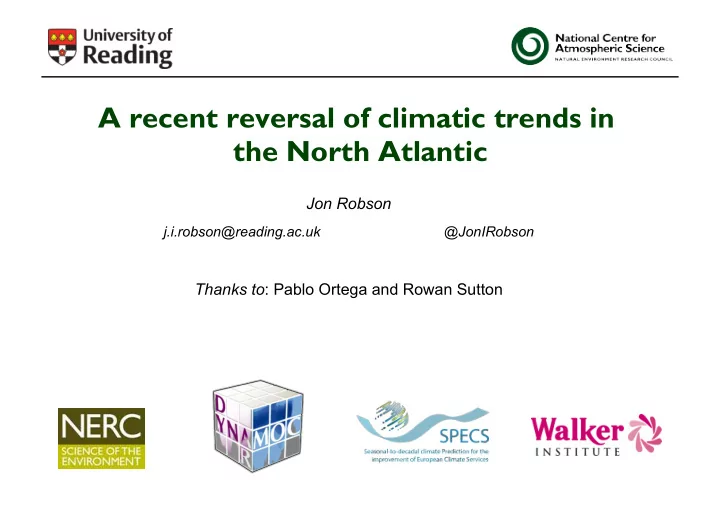

A recent reversal of climatic trends in the North Atlantic Jon Robson j.i.robson@reading.ac.uk @JonIRobson Thanks to : Pablo Ortega and Rowan Sutton
Motivation: Atlantic Multi-decadal Variability Robson et al, 2012 Substantial evidence that AMV has had important climate impacts, but what has been driving it? AMOC, Aerosols, surface fluxes ? However, we do think aspects of AMV may be predictable – Many studies are now predicting a cooling of the North Atlantic (Hermanson et al, 2014; Klower et al, 2014; McCarthy et al, 2015) Key questions are if, and when, the North Atlantic will enter a cold phase?
1990-2004 trends The North Atlantic warmed substantially following the mid-1990s �
1990-2004 trends The North Atlantic warmed substantially following the mid-1990s � Simultaneous changes in atmospheric circulation contributed to the warming � But , evidence suggests a strengthening of ocean circulation and heat � transport as a response to the persistent positive NAO was responsible ( i.e. Robson et al, 2012; Yeager et al, 2012,)
2005-2014 trends � Significant cooling of large regions of the North Atlantic since 2005.
2005-2014 trends � Significant cooling of large regions of the North Atlantic since 2005. � Simultaneous changes in atmospheric circulation contributed, but can not explain the cooling. � Suggests ocean circulation changes are important
Sensitivity of trends? � The trends are sensitive to the inclusion of winter 2013/2014, which had extreme surface heat loss (Grist et al, 2015) � However, 0-700m heat and salinity content trends are not sensitive � Brings confidence that this is a decadal time-scale change.
Ocean circulation changes ? Observations shows that � that AMOC has declined in strength since 2004 (i.e Smeed et al, 2013) � Model relationship between deep Labrador Sea density would suggests a further weakening of the AMOC Should be expected Robson et al, 2014, Nat Geo
Evidence of ocean circulation change? T [C] and Kgm -3 S [PSUx10] Warming of the North East Atlantic followed the peak in deep Labrador Sea � density in 1995
Evidence of ocean circulation change? T [C] and Kgm -3 S [PSUx10] Warming of the North East Atlantic followed the peak in deep Labrador Sea � density in 1995 This region has now cooled to temperatures last seen in the early 1990s � Magnitude of cooling is -0.45C or -1.5x10 22 J � Equivalent to a persistent surface flux cooling of -4.5Wm -2 or heat budget � deficit of -0.05PW sustained over a decade
Simulated upper-ocean trends Perform a composite analysis of trends associated with decreasing 1000-2500m Labrador Sea density in HadGEM3-GC2 – 9 largest 15-yr trends Declines in Labrador Sea density are associated with a weakened ocean circulation, particularly the AMOC Upper ocean cools and freshens following a decrease in deep Labrador Sea density - consistent with weakened heat and salt transport Surface flux changes can not explain the cooling in the model
Implications? S [PSUx10] T [C] and Kgm -3 Density trend in the deep Labrador Sea is still negative � Model based relationships would suggest that further cooling � should still be expected A return to anomalously cold Atlantic SST over the next decade? �
Summary The North Atlantic warmed significantly in the mid-1990s following a peak in � the deep Labrador Sea density. Heat content in the North East Atlantic peaked in ~2005 The North East Atlantic has cooled considerably over the past 10 years. The � cooling is ~ 1.5x10 22 J and consistent with a persistent -0.05PW deficit in the heat budget over a decade. The cooling is.. � not simply explained by simultaneous changes in the Atmosphere (i.e. Surface fluxes, - Ekman upwelling) consistent with the expected simulated response to a reduction in deep Labrador Sea - Density The density trend has continued to decline - further cooling should be � expected.
Summary The North Atlantic warmed significantly in the mid-1990s following a peak in � the deep Labrador Sea density. Heat content in the North East Atlantic peaked in ~2005 The North East Atlantic has cooled considerably over the past 10 years. The � cooling is ~ 1.5x10 22 J and consistent with a persistent -0.05PW deficit in the heat budget over a decade. The cooling is.. � not simply explained by simultaneous changes in the Atmosphere (i.e. Surface fluxes, - Ekman upwelling) consistent with the expected simulated response to a reduction in deep Labrador Sea - Density The density trend has continued to decline - further cooling should be � expected. Thanks!
Surface flux changes Observations Era-I NCEP EK-NCEP � Surface flux changes do not explain the change in ocean heat content since 2005
Are the changes what we’d expect? We analysed deep Labrador Sea density trends in the new version of HadGEM3-GC2 (N216, ORCA025) We currently have ~300 years Construct a composite of the 9 largest independent decreases in Labrador Sea density. Upper ocean trends lag density trends by 5 years . Drift is removed using a linear trend from each grid-point.
Simulated upper-ocean trends Simulated NAO trend also acts to cool the North Atlantic But, spatial pattern can not explain the cooling – Ocean circulation is key
So far I’ve argued that the changes in the ocean are not consistent with surface flux changes, and are consistent with the simulated model But why do the trends look so different? Does this really mean that some other process is more important?
But.... Are simulated and observed trends the same? Yes, in the Eastern subpolar gyre
Probably yes, in the wider North East Atlantic
HiGEM 2005 initialised prediction � HiGEM also captures a cooling of the Eastern SPG - Dominated by a reduction in ocean advection.
Variability or trend?
Recommend
More recommend